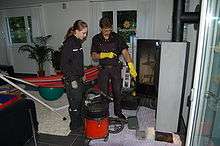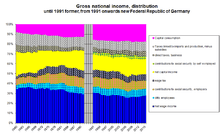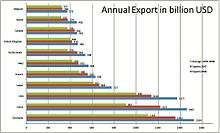German model
The term German model is most often used in economics to describe post-World War II West Germany's means of using (according to University College London Professor Wendy Carlin) innovative industrial relations, vocational training, and closer relationships between the financial and industrial sectors to cultivate economic prosperity.[1]
Industrial relations
Under the German model, unions are organized at the industry level and co-exist with works councils at both the plant and company levels.[2] These unions negotiate wage determination with employers' associations. The strength of this setup is the cooperation among unions and management councils. This is unique among Western countries, which have been marked by either substantial weakening of union powers (such as in the United States and United Kingdom) over the last twenty years, or consistent union conflict (such as in France and Italy, where unions have remained strong).
Consensus model
As in relations between unions and employers, the German model also seeks to harmonize relations between regulatory bodies and affected parties, as well as between individual companies to prevent ruinous competition within the scope of applicable antitrust law. Considered an outgrowth of the non-confrontational culture of postwar Germany, finding a common denominator was often the main goal in such relationships.
Vocational education and training

The system of vocational education is perhaps the most important component of the German model, and is still very prevalent in the German educational system. In Germany, there is a much heavier emphasis on apprenticeships for skilled positions, taught by expert worker-instructors. It has been made possible through long-term politics, focusing on establishing stronger links between the dual vocational education and training system and institutes of higher education, on improving integration into vocational training through basic skills and permeability and on establishing national coverage of branch-specific regional initial and continuing training centres.[3]
As such, there is a lower percentage of university students in Germany when compared to other Western countries, and a much lower percentage of persons entering the workforce for on-the-job training.
Vocational training is required for a large number of occupations. At the end of vocational training, a highly regarded certification qualification is awarded that is valid for a range of over 400 occupations. This is in stark difference to other European countries, where the number of controlled occupations is much smaller .
Critics cite inflexibility of the school system as the main disadvantage. Some 60% of graduates change their profession within 10 years of graduation .
Financial and industrial relations
German banks have a much larger role in shaping the industrial sector than those in other Western countries. Rather than simply collecting savings and investments and issuing loans, most German banks have large interests in the commercial sector. As such, many corporate boards offer seats to high-ranking German banking officials, whose banks are often investors in the corporation. As a result, they seek to promote long-term investment in the overall health of the companies they are working with.
Future of the German model
Since the German reunification German prosperity has declined compared to pre-unification West German levels, and the German unemployment rate reached record levels: 12.6% (according to national definition) as of March 2, 2005,[4] the highest rate since World War II. The failure of the German model to maintain standards of high performance has led experts to speculate about its demise, despite having been adopted successfully in other countries' corporations since its peak. Others see the relative decline as an unavoidable consequence of integrating the much less advanced GDR economy and 17 million new citizens, which necessitated a transfer of over 1.3 trillion Euros from west to east as of 2009.
Much of the political discourse regarding reforms in recent years revolved around the question of how to modify the German model (and the political conditions forming its framework) to sustain it in a globalised economy. Ex-Chancellor Gerhard Schröder's reforms, called "Agenda 2010", made some steps towards such a goal, but also brought with them much controversy. Nonetheless, after years of 'painful' reforms, the German economy seems to have got back on track. The wage share, however, measured as compensation of employees as percentage of gross national income, was declining in Germany since the 1980s.

Unemployment has fallen below 10% (according to national definition) for the first time in years and economic growth reached 2.7% in 2006.[5]
In June 2016, the unemployment rate was reported as 5.9% by the German Federal Employment Agency (Bundesagentur für Arbeit).[6]
Whether this is an ongoing development is however a matter of continuing debate, as are further reforms.
Counter-argument: Rise of the German model

As of 2009 and the recent worldwide economic downturn, some analysts [7] have speculated that the German model of social capitalism is resurgent and is the most responsible economic system that still ensures the survival of the free market. With recent economic schemes and company abuses, such as in the Bernard Madoff scandal,[8] the Enron scandal, and the financial crisis of 2007–2010, the German model of a rigidly structured and regulated economy has become more attractive.
From 2003 to 2008, Germany (a nation with only 80 million inhabitants) was the world's biggest exporter. In 2009, China (1.3 billion inhabitants) overtook Germany in exports.[9] One of the reasons for this are the Hidden Champions as a result of the German Model.[10] Germany's Hartz Reforms are and growing low-wage sector are believed to have weakened the core setup of this German Model.[11]
References
- Carlin, Wendy (1996). "West German growth and institutions, 1945-90". In Crafts, Nicholas; Toniolo, Gianni (eds.). Economic Growth in Europe Since 1945. Cambridge University Press. p. 484. ISBN 9780521499644.
- Vitols, Sigurt (2005). "Globalization and the transformation of the German model". In Stubbs, Richard; Underhill, Geoffrey R D (eds.). Political Economy and the Changing Global Order (PDF) (3 ed.). Oxford: Oxford University Press. ISBN 9780195419894. Archived from the original (PDF) on 2014-02-22. Retrieved 2014-02-16.
- UNEVOC- World TVET Database
- German Joblessness Hits High, Economy Stagnates in Forbes 2005-08-03
- Eurozone sees revival in growth in BBC News 2007-02-13
- Umfassende Arbeitsmarktstatistik im Juni 2016, 2017-07-10)
- Germany's orderly 'social market' in BBC News 2009-01-19
- From behind the curtain, Madoff drew in victims in New York Times 2009-01-16
- German export to remain world's biggest in 2008, difficult year ahead, cinaview at 2008-12-19. German exports rose in November 2009; China overtakes Germany as the world's top goods exporter, finfacts at 2010-01-08.
- Simon, Hermann: Hidden Champions of the 21st Century : Success Strategies of unknown World Market Leaders. London: Springer, 2009.- ISBN 978-0-387-98147-5.
- Tripathi, Ravi Kant. "Questioning the claim of Germany's 'employment miracle'". The Conversation. Retrieved 2019-09-23.
Further reading
- Edinger, Lewis J. and Brigitte L. Nacos. 1998. "Capitalism with a Human Face." pp. 145–195 in From Bonn to Berlin: German Politics in Transition. New York: Columbia University Press.
- Streeck, Wolfgang. 1997. "German Capitalism: Does It Exist? Can It Survive?" pp. 33–54 in Political Economy of Modern Capitalism: Mapping Convergence and Diversity, edited by C. Crouch and W. Streeck. London/Thousand Oaks: Sage.
- Roesler, Jörg. 1997. "The Rise and Fall of the Planned Economy in the German Democratic Republic, 1945-89." pp. 482–497 in The Economic Development of Germany Since 1870. Volume 2, edited by Wolfram Fischer. Cheltenham, UK/Lyme, N.H.: Elgar.
- Pickel, Andreas. 1997. "The Jump-Started Economy and the Ready-Made State." Comparative Political Studies 30 (Apr):211-241.
- Vocational education in Germany, UNESCO-UNEVOC
